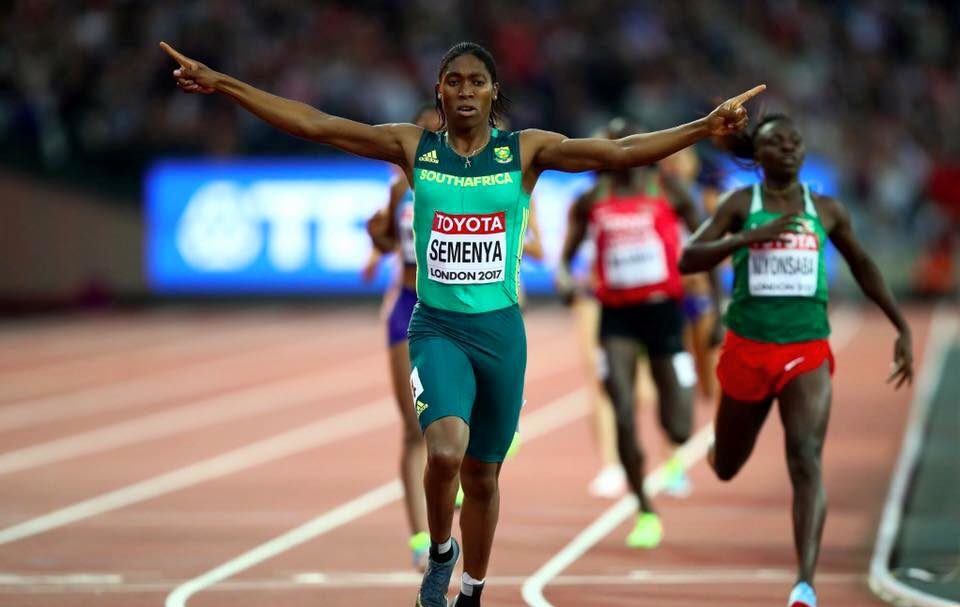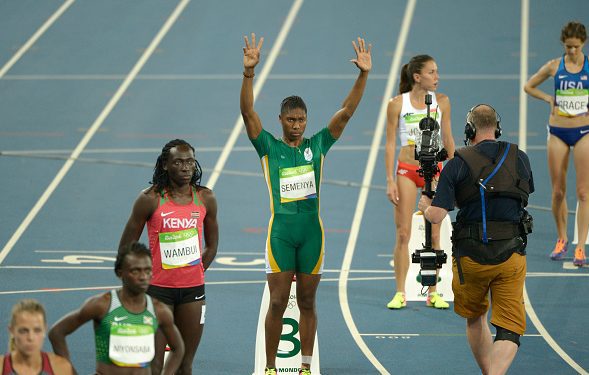Caster Semenya and testosterone: did the CAS get it right?
CAS's decision to uphold the IAAF's testosterone rule for female athletes comes with a number of caveats

Earlier today the Court of Arbitration for Sport announced it had decided in favour of the IAAF and against Caster Semenya in the matter of her testosterone levels. But the decision was announced with a number of caveats attached that highlight the complexity of the issues, and that in some people’s minds undermine the decision itself.
RELATED: Caster Semenya loses appeal on testosterone

Many people see no problem with a rule that seems designed to protect the integrity of women’s athletics (as the IAAF claims). It seems obvious that if a small minority of female athletes with naturally elevated testosterone wins all the races, that the playing field is not level, and that setting an appropriate maximum on allowable testosterone levels in female athletes is a reasonable solution.
But the caveats raised by the CAS itself are significant. It admits that one of the three judges felt the testosterone rule should be thrown out, but that he was overruled by the other two. It conceded that the rule is discriminatory, though it claims such discrimination is appropriate because it’s protecting women’s sport. It expressed concerns about athletes’ ability to comply and about the enforceability of the testosterone rule. It admitted the rule’s applicability in the 1,500m distance (which Semenya has occasionally raced) is questionable. And it admits to concerns about the potentially harmful side effects of hormone treatments to lower testosterone. According to a report in the Guardian, considering these caveats, Semenya’s team has asked the IAAF to delay implementation of the testosterone rule.
Here is the press statement. #CAS has ruled in favour of the IAAF, and thus all DSD athletes from 400m to the mile, including #semenya must now reduce #testosterone levels to compete. You know when your Mac does that spinning beachball thing? That’s been me since hearing this… pic.twitter.com/VoxoXRouu8
— Ross Tucker (@Scienceofsport) May 1, 2019
One of Semenya’s lawyers is Toronto-based James Bunting, who appeared in a CBC News interview this morning. Beyond the caveats listed in the decision, Bunting pointed out the irony of requiring athletes to effectively dope themselves (to bring down their testosterone) in order to compete. He also pointed out that “there is no basis to discriminate against a natural genetic variation any more than there are other natural genetic variations, such as someone being taller or having enhanced lung capacity.”
RELATED: Olympic silver medallist goes public about her hyperandrogenism
Bunting, who also acted for the Indian sprinter with DSD, Dutee Chand, who appealed a similar IAAF ruling in 2015, goes on: “In sport we celebrate the genetic outliers. We celebrate those people who have differences that make them exceptional. They become our heroes. And Ms. Semenya is one of those heroines… It doesn’t make sense to discriminate against this one genetic variation when we celebrate all others.”
Chand won a partial victory: she and other athletes with what the IAAF terms differences of sexual development, or DSD, were allowed to compete without lowering their testosterone, while the IAAF was given two years to explore the issue and come up with a better solution. Its solution was to make the rule twice as strict. Whereas in 2011 it proposed an upper limit of 10 nmol/L, now the rule is five nmol/L. This is the limit that was upheld by the CAS in today’s ruling.
My gym workout pic.twitter.com/6Mv0Rh3d7T
— Dutee Chand (@DuteeChand) February 21, 2018
One might assume that female athletes unaffected by DSD would support the decision, since it would seem to protect their ability to compete at the top level of their sport. And no doubt many do. But at least two notable dissenters have argued eloquently against the IAAF’s position.
Retired athlete Madeleine Pape competed against Semenya in the heats at the 2009 world championships. At the time, as she explains in today’s Guardian, she joined the crowd complaining that Semenya clearly wasn’t entirely female and shouldn’t be allowed to dominate. “The path of least resistance is to turn away from information and perspectives that might undermine one’s investment in the simplistic notion that sex is binary and testosterone is unfair (at least in women),” Pape writes.
I don't try to be controversial. I get anxious about appearing in the media. I like to listen, not just speak. But I wrote this piece in solidarity with @caster800m and other athletes with high T who are as much my sisters on the track as any other women. https://t.co/M8Aj0vh1BQ
— Madeleine Pape (@Madeleine_Pape) May 1, 2019
But in the ensuing years, she completely changed her mind. Why? Mainly because “biological sex and athletic ability are both far too complex for scientists to reduce to measures of testosterone.” And because by coincidence, she had met and become friends with some female athletes with similar hormonal characteristics to Semenya’s. “The issue had shifted from one I could keep at a distance and discuss in the abstract to one that implicated the lives of people I actually knew and cared about,” she writes. Pape felt so strongly about the issue that she testified in support of Chand in 2015.
RELATED: Is Caster Semenya resigned to racing 5,000m?
The World Medical Association urges physicians not to implement IAAF rules on classifying women athletes.
I stand with @caster800m ❤️https://t.co/7xRI8AIR2Z https://t.co/YTQnOQL7uS— Kirsti Miller (@KirstiMiller30) May 1, 2019
Retired Canadian racewalker, co-founder of AthletesCAN and former vice-chair of Athletics Canada Ann Peel shares Pape’s opinion. “I think there is nothing right about the CAS decision on Caster Semenya,” Peel said in a telephone interview. “Basically they’re going to hobble Caster so that weaker women can win. Meanwhile, nobody tries to hobble Usain Bolt so weaker men can win… DSD is this made-up term by the IAAF, anyway. Those women have no more right to win than Caster. She’s magnificent. Let’s celebrate her.” Peel also points out that the World Medical Association has condemned the decision as unethical and based on weak science, and urged doctors not to participate in any artificial testosterone-lowering of athletes.
https://twitter.com/RogerPielkeJr/status/1123967813855506432
In an impassioned opinion piece in the Globe and Mail in March, Peel roundly condemned the very idea of men continuing, in 2019, to make decisions about women’s bodies: “Athletes or not,” she writes, “we are women living in a patriarchal society, and are still subject to misogyny. By putting up with this, we allow men further control of women’s bodies, and Ms. Semenya will likely not be the last to suffer. Who, and what, is next?”
It’s a sad day for humanity.
It’s a sad day for sport. #HumanRightsAreAthleteRights ✊ https://t.co/OzlF3Kx08r— AthletesCAN (@AthletesCAN) May 1, 2019
Significantly, the Canadian Centre for Ethics in Sport (CCES), the Canadian Association for the Advancement of Women in Sport and Physical Activity (CAAWS) and AthletesCAN have all critized the decision, in particular that female athletes determined to be DSD be required to artifically lower their testosterone. It also called on the CAS to make public the full 165-page report on its decision (redacted to protect the medical information of specific individuals).
Semenya is now facing a number of decisions in the wake of this morning’s announcement by the Court of Arbitration for Sport regarding her testosterone levels: she can comply, and start taking testosterone-lowering medication by May 8 to be eligible to compete at this year’s world championships in September. Otherwise, she has two options: appeal the CAS’s decision to the Swiss Federal Tribunal within 30 days (something her team says it is considering, though it would likely mean she would be unable to compete in the 800m at worlds), or move up to the 5,000m, which is not affected by the testosterone rule.
Semenya raced the 5,000m last weekend, which may indicate she’s considering that option, and she has claimed in the past that she would do that before she would lower her testosterone. It seems likely also that she will continue the fight, since she has claimed many times that all this adversity only makes her stronger.
Peel says, “High T [testosterone]? We don’t actually know if that’s why she’s so strong. Maybe it’s her resilience. This woman’s been poked and prodded for 10 years, and she still comes on strong. She’s a phenomenal athlete.”
Pape (the athlete who changed her mind on the issue) has a suggestion for the IAAF: “the IAAF could consider the road it has not yet travelled: engage in educational efforts aimed at promoting informed discussion, allaying fears of the unknown and promoting understanding as a viable alternative to exclusion. In other words, the IAAF could take the lead in creating a sporting environment in which it becomes possible to truly recognise women with high testosterone as the “humans, daughters, and sisters” that our president, Seb Coe, claims them to be at the same time as he denies their right to participate.”


